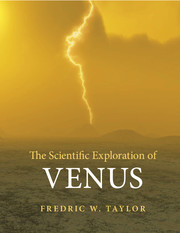Book contents
- Frontmatter
- Contents
- Overview
- Prologue
- A note on scientific units
- Acknowledgements
- Part I Views of Venus, from the beginning to the present day
- Part II The motivation to continue the quest
- Chapter 9 Origin and evolution
- Chapter 10 Atmosphere and ocean
- Chapter 11 A volcanic world
- Chapter 12 The mysterious clouds
- Chapter 13 Superwinds and polar vortices
- Chapter 14 The climate on Venus, past, present and future
- Chapter 15 Could there be life on Venus?
- Part III Plans and visions for the future
- Epilogue
- References and acknowledgements
- Appendix A Chronology of space missions to Venus
- Appendix B Data about Venus
- Index
- Plate section
Chapter 13 - Superwinds and polar vortices
from Part II - The motivation to continue the quest
Published online by Cambridge University Press: 05 September 2014
- Frontmatter
- Contents
- Overview
- Prologue
- A note on scientific units
- Acknowledgements
- Part I Views of Venus, from the beginning to the present day
- Part II The motivation to continue the quest
- Chapter 9 Origin and evolution
- Chapter 10 Atmosphere and ocean
- Chapter 11 A volcanic world
- Chapter 12 The mysterious clouds
- Chapter 13 Superwinds and polar vortices
- Chapter 14 The climate on Venus, past, present and future
- Chapter 15 Could there be life on Venus?
- Part III Plans and visions for the future
- Epilogue
- References and acknowledgements
- Appendix A Chronology of space missions to Venus
- Appendix B Data about Venus
- Index
- Plate section
Summary
The circulation and dynamics of Venus’s atmosphere behave in ways that sometimes remind us of terrestrial meteorology, but mostly seem quite bizarre. Yet we routinely compute the dynamical behaviour of Earth’s atmosphere, for weather forecasting and other reasons, and it should be possible to do the same for Earth’s twin. However, even the most basic behaviour on Venus, the four-day ‘super-rotation’, is proving hard to diagnose or to replicate. Despite a great deal of attention by groups using some of the most sophisticated computers and models, Earthlike simulations with Venusian parameters inserted have tended to circulate too slowly.
A lot of meteorological activity – weather – has been observed in Venus’s atmosphere by orbiting spacecraft and measured in situ by descent probes, but understanding and interpreting what is going on is still at an early stage. Researchers continue to argue about whether lightning occurs, and although it probably does, there is no clear picture of how or where it is generated. Some of the small-scale and transitory features, such as the waves seen in the ultraviolet images of the cloud tops, and some of the global and semi-permanent behaviour, for example the Hadley circulation, have some recognisable relationship to similar behaviour on the Earth, although they may have to be scrutinised closely to see it. Other important phenomena seem fairly unique to Venus, not just the fast winds that circle the equator, but the complexity of the giant vortices at each pole, and the behaviour in the upper atmosphere, where the circulation seems to change to a completely different regime.
- Type
- Chapter
- Information
- The Scientific Exploration of Venus , pp. 197 - 214Publisher: Cambridge University PressPrint publication year: 2014



